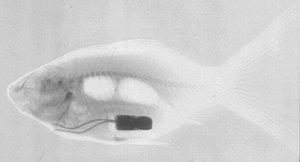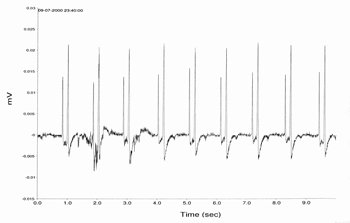The Heart of Fish Research
The following is an extraction from a recent poster presented by Van Ginneken, Ph.D., P.Ch. Snelderwaard and Kramer, Ph.D.
Fish are one of the most successful vertebrate groups evolved in evolution. They occupy a wide range of environments varying from the polar areas, the deep sea, to the tropics. The advent of telemetry in research has enabled the acquisition of basic information from individual intact stress free fish. Parameters such as heart rate, blood pressure, stroke volume and body temperature can be recorded for long periods varying from weeks to months and are essential for the ichthyologist. This physiological information can be applied in varying research areas like evolutionary biology, behavioral studies, population dynamics, aquatic toxicology and studies concerning the energy metabolism.
We, for the first time, developed an implantation technique for a telemetry transmitter in a 62 gram Goldfish (Carassius auratus), which enables us to monitor heart rate (HR), electrocardiogram (ECG) and body temperature (BT) in a freely swimming fish.
Implantation of the transmitter (TA10-ETA-F20, DSI) was performed by first anaesthetizing the fish with 200 ppm MS-222 solution in the water. Then a 1.5 cm incision above the pectoral fin was made and the transmitter body was implanted in the abdominal cavity. The monitoring system consisted of the following: A receiver board (RPC-1, DSI), placed under the aquarium, monitoring the transmitter signal. A multiplexer (Data Exchange Matrix, DSI) consolidating signals from multiple transmitters. And an IBM-compatible personal computer (Compaq Presario 1510) with data capture and analysis software (Dataquest A.R.T. 1.01, DSI). The total set up was placed in a temperature-controlled room (16 deg. C) with a 12:12 light-dark periodicity. The temperature of the water in the aquarium was continuously recorded with a Hewlett Packard 2801A Quartz thermometer and kept constant at 15 deg. C.

X-ray picture of the Goldfish Transmitter implanted in the abdominal cavity two days after surgery.
The following telemetry research experiments were performed after a 7-day recovery
Experiment A: Two days registration for day and night cycle. No day and night cycle was observed in HR or BT of the fish. The first day, after introducing the fish in the experimental set up, the HR was during daytime 55 beats per minute (bpm) and during night 52 bpm. The second day, the HR was during daytime 57 bpm and during night 56 bpm.
Experiment B: Adrenaline: low dosage (0.033 ml 10-6 mM, i.p.), intermediate dosage (0.033 ml 10-3 mM, i.p.), high dosage (0.5 ml 10-3 mM, i.p.), with one hour of data collection following each dosage. The low, moderate and high dosage of adrenaline gave a HR of 36, 62 and 71 bpm respectively during the one hour after administration of the drug.

A characteristic ECG registration in the freely swimming Goldfish Monitored via radiotelemetry.
To learn more about the use of telemetry in research contact: Dr. Vincent van Ginneken and Peter Snelderwaard, Institute of Evolutionary and Ecological Sciences, Integrative Zoology, Van der Klaauw Laboratorium, Leiden University, P.O. Box 9511, 2300 RA Leiden, The Netherlands, E-mail: ginneken@rulsfb.leidenuniv.nl
Dr. Klaas Kramer, Department of Safety and Environmental Affairs, Free University, Van der Boechorststraat 1, 1081 BT Amsterdam, The Netherlands, E-mail: mailto:k.kramer@dienst.vu.nl
Cardiovascular measurements of small fish by radio-telemetry: A preliminary study. V. van Ginneken P. Ch. Snelderwaard H.-P.Voss R. van der Linden D. van der Reijden A. Gluvers G. van den Thillart K. Kramer Poster Presentation at Measuring Behaviour Meeting 2000 2000